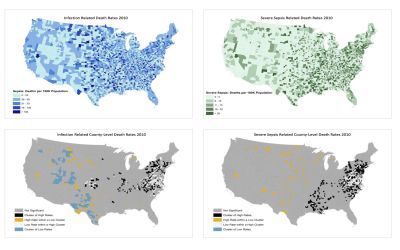New Research Identifies Infection and Sepsis-Related Mortality Hotspots Across the U.S.


Â
In the past, researchers have sought to determine the geographic distribution of many life-threatening conditions, including stroke and cardiac arrest. Now, researchers at the Perelman School of Medicine at the University of Pennsylvania have created the first U.S. map that pinpoints hotspots for infection and severe sepsis related-deaths with notable clusters located in the Midwest, mid-Atlantic, and the South. The research is a critical first step in helping to determine which areas of the country require vital public health resources to fight these deadly diseases. The new research will be presented at the annual meeting of Society for Academic Emergency Medicine in Atlanta.
Infection-related deaths are a leading cause of morbidity and mortality in the U.S., affecting over 1 million people a year, and costing $17 billion annually, says lead study author David Gaieski, MD, an associate professor of Emergency Medicine at Penn. And while our understanding of the causes of infection-related death rates has improved, we are still struggling to prevent these diseases and indentify individuals who are most susceptible. We need to be able to pinpoint the geographic distribution of infection-related death rates in order to further study how and why these infections are happening in these areas and the best methods to prevent these deaths.
Sepsis is the 10th leading cause of death in the United States. With an estimated 750,000 cases annually and a nearly 40 percent mortality rate, severe sepsis is also one of the most common causes of death in hospital critical care units.
To better understand what areas of the country are most at risk for severe sepsis and other infection-related deaths, the research team collected U.S. county death data from the 2010 Multiple Cause of Death data files (compiled by the National Center for Health Statistics) and combined it with 2010 Area Resource File demographic data for a comprehensive view of national variations. The authors note that previous research had only been able to identify potential trends on a state level.
Infection-related deaths were identified using ICD-10 primary cause of death codes for infection and severe sepsis. Hotspots were defined as regions where the infection death rate was significantly higher than the national mean and surrounding counties. The analysis revealed four hotspots: 1) two regions that had three times the national mean of infection-related deaths located across the Midwest and mid-Atlantic and 2) two regions that had four times the national death rate from severe sepsis, located in the South and mid-Atlantic.
In addition to the hotspots, the research team also indentified one coolspot cluster, an area that had disproportionately low rates of deaths caused by these infections. The coolspot cluster consisted of 157 counties located across the Southwest and Mountain states. The research team notes that these coolspot counties might yield important insights as well, including particular screening and treatment protocols that may be in place in these areas.
This analysis may help target focused geographical interventions to improve the dissemination and implementation of evidence-based care, says senior study author Brendan G. Carr, MD, MA, assistant professor of emergency medicine, surgery and epidemiology at Penn. Further study is required to clarify the geographic variability we observed, but we believe this new resource will be a helpful tool for researchers and public health officials.
Additional authors from Penn include Anish Agarwal, MD, MPH, Catherine S. Wolff, Douglas Wiebe, PhD, and Mark E. Mikkelsen, MD.
Source: University of Pennsylvania
Â
Unraveling a Candida auris Outbreak: Infection Control Challenges in a Burn ICU
March 19th 2025A Candida auris outbreak in a burn intensive care unit (BICU) in Illinois has highlighted the persistent challenges of infection control in high-risk health care settings. Despite rigorous containment efforts, this multidrug-resistant fungal pathogen continued to spread, underscoring the need for enhanced prevention strategies, environmental monitoring, and genomic surveillance.
Unmasking Long COVID: Dr Noah Greenspan on Recovery, Research Gaps, and the Future of Treatment
March 18th 2025Dr Noah Greenspan discusses the evolving understanding of long COVID, current treatment strategies, diagnostic challenges, and the critical need for research and awareness in post-viral syndromes.
From Shortages to Security: How Reusable Health Care Textiles Can Transform Infection Prevention
March 7th 2025Reusable health care textiles enhance infection prevention, reduce waste, and strengthen supply chains. Hygienically clean textiles offer a sustainable, cost-effective alternative to disposable PPE, ensuring patient safety and environmental responsibility.
Unraveling a Candida auris Outbreak: Infection Control Challenges in a Burn ICU
March 19th 2025A Candida auris outbreak in a burn intensive care unit (BICU) in Illinois has highlighted the persistent challenges of infection control in high-risk health care settings. Despite rigorous containment efforts, this multidrug-resistant fungal pathogen continued to spread, underscoring the need for enhanced prevention strategies, environmental monitoring, and genomic surveillance.
Unmasking Long COVID: Dr Noah Greenspan on Recovery, Research Gaps, and the Future of Treatment
March 18th 2025Dr Noah Greenspan discusses the evolving understanding of long COVID, current treatment strategies, diagnostic challenges, and the critical need for research and awareness in post-viral syndromes.
From Shortages to Security: How Reusable Health Care Textiles Can Transform Infection Prevention
March 7th 2025Reusable health care textiles enhance infection prevention, reduce waste, and strengthen supply chains. Hygienically clean textiles offer a sustainable, cost-effective alternative to disposable PPE, ensuring patient safety and environmental responsibility.
2 Commerce Drive
Cranbury, NJ 08512